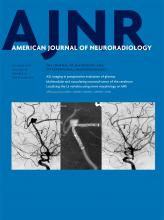Abstract
BACKGROUND AND PURPOSE: The implications of basal ganglia T1 hyperintensity remain unclear in patients with hereditary hemorrhagic telangiectasia. This study was performed to assess the prevalence of this imaging finding in a large cohort of patients with hereditary hemorrhagic telangiectasia and to identify any association between this phenomenon and other disease manifestations.
MATERIALS AND METHODS: In this retrospective study, we identified all patients at our institution diagnosed with definite hereditary hemorrhagic telangiectasia from 2001 to 2017. Patients who did not undergo brain MR imaging were excluded. Patient demographics, laboratory results, and hereditary hemorrhagic telangiectasia disease characteristics were noted. Basal ganglia hyperintensity was evaluated both qualitatively and quantitatively relative to the signal intensity in the ipsilateral thalami. Statistical analysis was performed with commercially available software.
RESULTS: A total of 312 patients (41% men, 59% women; mean age, 51 ± 18 years) with definite hereditary hemorrhagic telangiectasia were identified. Basal ganglia T1 hyperintensity was present in 23.4% of patients and demonstrated a statistically significant association with older age (P < .001), increased hepatic AVMs (P < .001), high cardiac output state (P < .001), hepatic failure (P = .01), elevated peak serum alkaline phosphatase level (P = .03), and increased total bilirubin count (P = .03). There was no significant association with sex, hereditary hemorrhagic telangiectasia genetic mutation status, parkinsonism, or serum transaminase levels.
CONCLUSIONS: Basal ganglia T1 hyperintensity occurs in >23% of patients with hereditary hemorrhagic telangiectasia and is associated with hepatic vascular malformations, hepatic dysfunction, and elevated cardiac output. The presence of this finding on screening MR imaging in patients with hereditary hemorrhagic telangiectasia should prompt further evaluation for visceral lesions causing arteriovenous shunting.
ABBREVIATIONS:
- ALT
- alanine aminotransferase
- ALK1
- activin receptor-like kinase 1
- AST
- aspartate aminotransferase
- ENG
- endoglin
- HHT
- hereditary hemorrhagic telangiectasia
- © 2017 by American Journal of Neuroradiology












